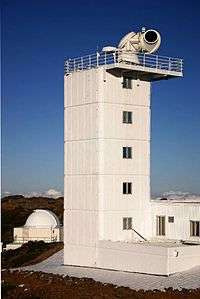Swedish Solar Telescope
 | |
| Organisation | Institute for Solar Physics, Royal Swedish Academy of Sciences |
|---|---|
| Location(s) | Roque de los Muchachos Observatory, La Palma |
| Coordinates | 28°45′35.04″N 17°52′50.65″W / 28.7597333°N 17.8807361°WCoordinates: 28°45′35.04″N 17°52′50.65″W / 28.7597333°N 17.8807361°W |
| Altitude | 2360m |
| Wavelength | Optical-NIR |
| Built | 2001 |
| Telescope style | Refracting telescope |
| Diameter | 98 cm |
| Angular resolution | 0.13 arcsec @ 500nm |
| Collecting area | 0.75 m2 |
| Focal length | 20.3 m @ 460 nm |
| Mounting | Alt-az |
| Enclosure | Turret |
| Website | http://www.solarphysics.kva.se/ |
The Swedish 1-m Solar Telescope[1][2][3] (or SST) is a refracting solar telescope at Roque de los Muchachos Observatory, La Palma in the Canary Islands. It is run by the Institute for Solar Physics of the Royal Swedish Academy of Sciences. The primary element is a single fused silica lens, making it the second largest optical refracting telescope in use in the world. The 110-cm lens has a clear aperture diameter of 98 cm. The SST is most often used as a Schupmann telescope, thereby correcting the chromatic aberrations of the singlet primary.
The SST is a vacuum telescope, meaning that it is evacuated internally to avoid disruption of the image from air inside. This is a particular problem with solar telescopes because of the heating from the large amounts of light collected being passed on to any air causing image degradation. As of 2005 it has produced the highest resolution images on the Sun of any telescope, using its adaptive optics system.
Currently, the SST is operating with an adaptive optics system with a 37-actuator deformable mirror from AOPTIX,[4] although upgrades are underway.
The SST superseded the SVST[5] – the Swedish Vacuum Solar Telescope – which was 47.5 cm in diameter.
Instruments
The SST has two modes of operation. One mode is a spectrograph mode, using the TRI-Port Polarimetric Echelle-Littrow[6] (TRIPPEL) spectrograph with a resolution of R = 230 000 (corresponding to 1.3 km/s at the solar surface). TRIPPEL is a Littrow spectrograph using a 79 grooves/mm echelle grating with a blaze angle of 63.43 degrees.
The other mode is an imaging mode, where imaging is split up in a red and a blue beam by a dichroic beamsplitter. The red beam has a tunable filter called CRisp Imaging SpectroPolarimeter[7][8][9] (CRISP) which operates from 510 to 860 nm and is able to measure polarization by using liquid crystal modulation combined with a polarizing beamsplitter. The total system uses three 1k × 1k Sarnoff CCDs, two are used for direct observations and the third is used in aiding the MOMFBD image reconstruction method. The blue beam is a setup with a total of 4 MegaPlus II es4020 cameras.
TRIPPEL
TRIPPEL, as mentioned above is the spectrograph mode of the SST.
TRIPPEL has a number of key useful features. It allows simultaneous observations at 3 different wavelengths, can in principle exploit the full spatial resolution of the SST, and has good polarimetric properties.
TRIPPEL’s wavelength range is about 380-1100 nm, and it has a moderate resolution for a solar telescope, with R being approximately 200,000. This corresponds to about 1.3 km/s on the solar surface.
See also

- List of solar telescopes
- Dutch Open Telescope
- Sunrise - a balloon-borne solar telescope
References
- ↑ Scharmer, Göran; Owner-Petersen, M.; Korhonen, T.; Title, A. (1999). T. R. Rimmele; K. S. Balasubramaniam; R. R. Radick, eds. "The New Swedish Solar Telescope". High Resolution Solar Physics: Theory, Observations, and Techniques. Astronomical Society of the Pacific Conference series. 183: 157–168. Bibcode:1999ASPC..183..157S.
- ↑ Scharmer, Göran; Bjelksjo, Klas; Korhonen, Tapio K.; Lindberg, Bo; Petterson, Bertil (February 2003). "The 1-meter Swedish solar telescope" (PDF). Proceedings of the SPIE. Innovative Telescopes and Instrumentation for Solar Astrophysics. SPIE. 4853: 341–350. doi:10.1117/12.460377.
- ↑ "Swedish 1-meter Solar Telescope". SST Wiki. Institute for Solar Physics. Retrieved 28 May 2011.
- ↑ Scharmer, Goran B.; Dettori, Peter M.; Lofdahl, Mats G.; Shand, Mark (February 2003). "Adaptive optics system for the new Swedish solar telescope" (PDF). Proceedings of the SPIE. Innovative Telescopes and Instrumentation for Solar Astrophysics. SPIE. 4853: 370–380. doi:10.1117/12.460387.
- ↑ Scharmer, Göran B.; Brown, David S.; Pettersson, Lennart; Rehn, John (1985). "Concepts for the Swedish 50-cm vacuum solar telescope". Applied Optics. 24 (16): 2558–2564. Bibcode:1985ApOpt..24.2558S. doi:10.1364/AO.24.002558.
- ↑ "TRIPPEL spectrograph". SST Wiki. Institute for Solar Physics. Retrieved 28 May 2011.
- ↑ "SST CRISP images". SST website. Institute for Solar Physics. Retrieved 28 May 2011.
- ↑ Scharmer, G. B. (March 2006). "Comments on the optimization of high resolution Fabry-Pérot filtergraphs". Astronomy and Astrophysics. 447 (3): 1111–1120. Bibcode:2006A&A...447.1111S. doi:10.1051/0004-6361:20052981. Retrieved 28 May 2011.
- ↑ Scharmer, G. B.; Narayan, G.; Hillberg, T.; de la Cruz Rodriguez, J.; Löfdahl, M. G.; Kiselman, D.; Sütterlin, P.; van Noort, M.; Lagg, A. (December 2008). "CRISP Spectropolarimetric Imaging of Penumbral Fine Structure". The Astrophysical Journal. 689 (1): L69–L72. arXiv:0806.1638
 . Bibcode:2008ApJ...689L..69S. doi:10.1086/595744.
. Bibcode:2008ApJ...689L..69S. doi:10.1086/595744.
External links
- Information on the SST from the Institute for Solar Physics
- Information on the SST at the Institute for Solar Physics wiki
- SST APOD pictures of a sunspot, the Venus transit, spicules on the solar surface, and bright points in the solar granulation.
- APOD picture of the Roque de los Muchachos Observatory. The SST is the third from the right.
| Wikimedia Commons has media related to Swedish Solar Telescope. |